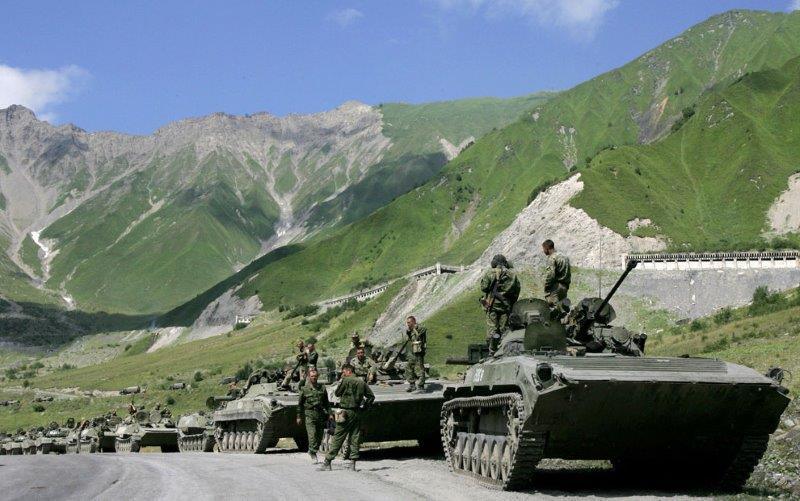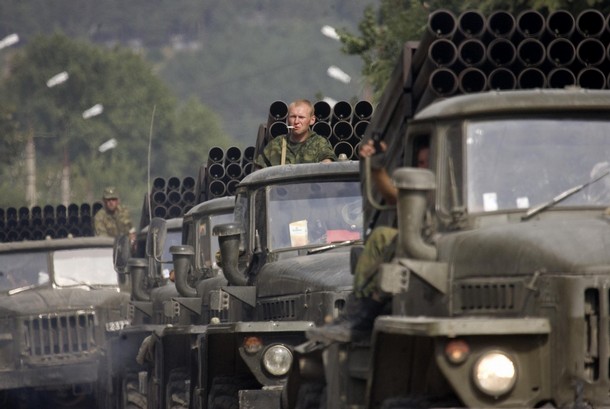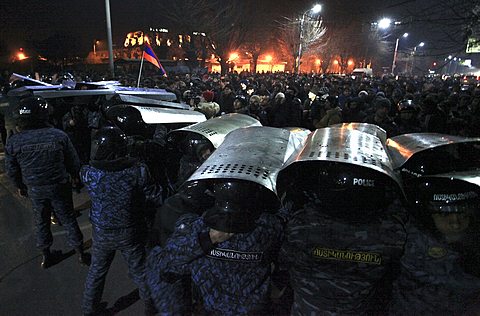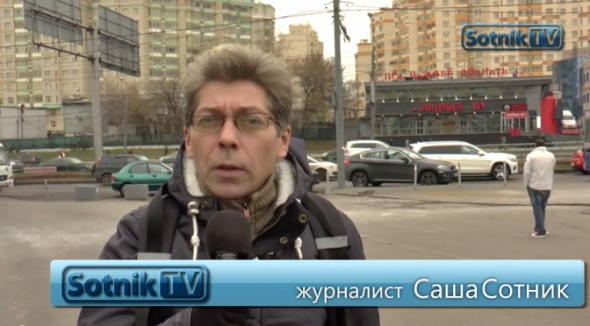Since the Russo-Georgian war of August 2008, the information battle about it has not stopped. After initially getting very negative press concerning their military aggression, the Russians “regrouped” and launched a massive propaganda counter-assault, using their existing networks in the West, particularly in Europe. This propaganda campaign sought to put the blame for the war on Georgia altogether, or at least to blur the difference between the aggressor and the victim in the eyes of the Western audience. In its attempt to blame Georgia, Russia did not stop before promoting obvious lies.

One of these lies was the claim that Georgian military units had started combat actions before the Russian military forces crossed the Georgian border. The facts point to the opposite. Units of Russia’s regular armed forces started flowing into the Tskhinvali region in the first days of August 2008, right after the completion of the large-scale military exercise, Kavkaz 2008, on 2 August.
On 5 August 2008, an intelligence battalion of the 33rd Mountain Infantry Regiment passed through the Roki tunnel and entered Georgia. At that time, 1,200 military servicemen of the Russian army were already deployed in the Tskhinvali region, even though the acceptable limit for the presence of Russian peacekeepers was set at 530, according to the existing agreement on Russia’s peacekeeping mandate. These facts are reported in an international study – The Guns of August 2008: Russia’s War in Georgia. On 6 August 2008, the Russian daily newspaper, Nezavisimaya Gazeta, along with other Russian media outlets, reported that the road on the north side of the Roki tunnel was packed with Russian military trucks and armored vehicles heading for the tunnel. At about 4 a.m. on 7 August, the Interior Ministry of Georgia intercepted telephone conversations of South Ossetian fighters saying that tanks and armored vehicles had entered the Tskhinvali region from Russia via the Roki tunnel. At 5 p.m. on the same day, a Russian TV channel, RTR Planeta, aired a statement of the then leader of Sukhumi regime, Sergei Bagapsh, expressing hope that everything would be fine with Tskhinvali because, as he said, “a battalion of the North Caucasus Military District” had already entered the region.

After the war, the Russian media published a great number of interviews with Russian military personnel who recounted their activities during the war. In a number of cases, they unwittingly confided that their military units had already been in the Tskhinvali region before the Georgian army started combat operations. For example, Captain Denis Sidristy of the 135th Motorized Rifle Regiment stated that, after the completion of Kavkaz 2008 military exercise, his unit stayed near the border with Georgia and, on 7 August, they received the order to move to the Tskhinvali region, which they did on the same day.
By the time President Mikheil Saakahsvili issued the command to launch the military operation, at 11:30 p.m. on 7 August, a number of Russian military units had already crossed Georgia’s borders. Among these were elements of the 135th and 693rd motorized rifle regiments and special units of the GRU, the Main Intelligence Directorate of the General Staff of the Armed Forces of the Russian Federation. In particular, parts of the 10th and 22nd GRU brigades were in the city of Tskhinvali and engaged in battles against Georgian military units in the morning of 8 August.
Apart from the units of the Russian regular army, the first days of August 2008 also saw an inflow of groups of “volunteer” fighters from Russia into the Tskhinvali region. On 4 August, the then leader of Tskhinvali regime, Eduard Kokoity said that 300 volunteers had come into the Tskhinvali region from North Ossetia and their number would soon reach 2,000. At the same time, the deputy governor of Russia’s Rostov Oblast, Dmitri Vodolatski, declared that the mobilization of Cossack volunteers, who were to be sent to Tskhinvali, was under way in the region. This process was organized by the Russian state and the Cossacks were rallying at the official mobilization locations. The majority of these volunteers were assigned to the 19th Motorized Rifle Regiment which took an active part in the war with Georgia. On 5 August, the representative of the Tskhinvali separatists in Moscow, Dmitri Medoyev, said that first groups of Cossack volunteers had already arrived in the Tskhinvali region.
A report of the EU-sponsored Independent International Fact-Finding Mission on the Conflict in Georgia, the so-called Tagliavini report, confirms that before the official start of Russian military operations (on 8 August), units of the Russian regular army, which did not belong to the peacekeeping battalion, were already in the Tskhinvali region. The report also says: “[t]here seems to have been an influx of volunteers or mercenaries from the territory of the Russian Federation to South Ossetia through the Roki tunnel and over the Caucasus range in early August.”
Preparations for a military operation were underway in Russia well before units of the Russian army crossed the borders of Georgia after 2 August 2008. In April 2008, Russia started deploying additional forces in Abkhazia. On 21 April, Moscow declared the deployment of a battalion from the 7th Air Assault Division, which was a clear breach of Russia’s peacekeeping mandate. During the same period, Russia also dispatched two units of special forces. On 3 May, Russia deployed a 400-man strong battalion of railroad troops to Abkhazia, which carried out repairs of the rail line from the Russian border to Ochamchire, a town near the administrative border with the rest of Georgia. This was also a gross violation of the peacekeeping mandate. The rail repairs were completed on 30 July, just one week before the war broke out. During the August war, this railway was used for the movement of numerous military units and their heavy equipment through the western Georgia.
From 15 July to 2 August 2008, Russia conducted a large-scale military exercise, Kavkaz 2008, near Georgia’s borders. During that exercise, participants were given a leaflet entitled “Soldier! Know Your Enemy!”, with the description of the Georgian armed forces. After the end of that exercise, the participating military units were not withdrawn; they remained on Georgia’s borders poised for action. Elements of these units crossed the border prior to the launch of combat operations by Georgian servicemen, whilst the remaining units did so thereafter.
Russia also initiated political preparations for their action against Georgia. On 14 February 2008, President Vladimir Putin declared that in the event of international recognition of the independence of Kosovo, Russia had action plans ready. On 17 February, Kosovo declared its independence, which was recognized by many states over the following days. Soon after it became clear what Putin’s plans were.
On 6 March, Russia withdrew from the 1996 treaty of the Commonwealth of Independent States, On Measures to Regulate the Conflict in Abkhazia, which prohibited it from establishing any official ties with the Sukhumi regime. On 21 March, the Russian Duma called on the government to recognize the independence of the separatist regions of Abkhazia and South Ossetia. On 3 April, Putin sent letters to the leaders of Georgia’s separatist regions, pledging his support. On 16 April, Putin issued an order instructing Russian state agencies to establish formal ties with the leadership of the separatist regions. These steps were followed by military preparations that culminated in the military aggression of August 2008.
The political and military preparations of Russia well before the outbreak of war indicate that the conflict was a deliberately planned and consistently implemented military-political operation. This operation pursued Russia’s goals in respect of Georgia. To say that the Russian armed forces had not crossed the Georgian border before Georgia started its military operations runs counter to the established facts and, consequently, constitutes a patent lie.
David Batashvili, political analyst from Georgia, May 2014
Aboth the author:
David Batashvili is a political analyst from Georgia. He worked at the Office of the National Security Council of Georgia from February 2008 until November 2013. He is the author of articles on security and political issues published in the Tabula magazine and other Georgian media, as well as on the Ukrainian web portal www.liga.net.
Annexes
Vladimir Putin’s position before the Russo-Gerogian War of 2008
Vladimir Putin’s position after the Russo-Georgian War of 2008





